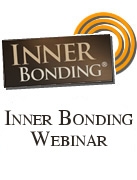Meditation as Loving Action
By Emily AgnewNovember 14, 2007
Emily Agnew offers a powerful way of attending to your Inner Child throughout the day, sharing her experience and insight about the synergy between breath awareness and Inner Bonding practice.
When I first learned about Inner Bonding, I attended to my Inner Child only when she was really upset. Sometimes I'd forget to check in at all for days in a row. Eventually I realized that I needed a daily practice, and I began to spend some time each morning, checking in. More recently, I began asking myself the question, "What about the rest of the day?" After all, feelings arise all day, not just in the morning, and might require loving action on the spot, minute by minute, hour by hour. How can I attend to my Inner Child moment to moment, while going through my typical day?
A helpful answer to that question came to me recently, as I resumed a sitting meditation practice that had become irregular after the birth of my daughter. I've been experimenting with a breath practice, noting the beginning of the in-breath and the beginning of the out-breath, and committing myself, one breath at time, to try and stay present until the next exhalation or inhalation. The practice is very simple, and very powerful. Because my breath is portable, breath awareness is both effective, and marvelously efficient. I have to breathe anyway, so paying attention to it doesn't take any extra time. This means I can do this practice not only in a sitting position, but during any activity of daily living. I've noticed that this brings me back down into my body in a very powerful way, noticing what I'm feeling, or if I'm judging myself or others or situations - and there I am, in the first step of the Inner Bonding model.
So, as I've attended to my breath off and on through the day, I've become much more continuously aware of my Inner Child, through awareness of feelings in my body. After a few days of this, it hit me that meditation is the essence of loving action, in the Inner Bonding sense, and that the presence it evokes is the presence of Spirit. Inner Bonding instructs me to sense my feelings with compassion, rather than diving into or being swallowed up by them, and this is exactly the kind of presence I find myself practicing when I attend to my breath. When I am present to my feelings in this way, I have choices how to respond to them. I can ask, "What would be loving action around these feelings?" I might just breathe with the feelings. Or I might stop what I'm doing and do some Inner Bonding. Or whatever else my guidance suggests. I am empowered to care for myself, moment by moment. The key is to observe without judging. Observing without judging is an essential form of loving action.
How do I know this practice is loving action for me? I know it because of the feedback I'm getting from my Inner Child. She is as happy as a clam when I do my best to stay in the present moment. This makes perfect sense, when you think about it. Children yearn for love, in the form of attention, and especially loving attention that doesn't have an agenda. That is a pithy description of meditation, and it makes sense that practicing this kind of presence can be a powerful form of loving action. Also, children are naturally very present, in stillness or in motion, staying absorbed in the present moment and disinclined to fret over the past or be anxious about the future. Play and creativity arise from this presence, and anything that fosters play is going to make my Inner Child happy. Spirit lives in the present moment, and my Child loves hanging out with Spirit. So she is very, very happy about all this.
I also see clearly that when I do my best to stay present in this way, I avoid upsetting myself about a lot of things in the first place. I've known this intellectually, but experiencing it is a different reality altogether. I think I might actually be experiencing what meditation teachers refer to as equanimity: more calm, and much less pain is coming up to be looked at. When pain does come up, I experience it differently. There is a sense of spaciousness around it, and it doesn't feel so climb-out-of-my-skin intolerable. In the reality of my daily life, there is rarely a real and present danger: no fire, no saber tooth tiger, no guy from the collection agency. In the present, I almost always AM fundamentally safe. I've been trying to tell my Inner Child we're safe, but when I stay present in my body, I actually experience the safety in a tangible way that renders words unnecessary. I feel wonder at the power and simplicity of this, and the clarity it offers me around what is usually happening if I feel upset: upset means I've left awareness of my body and am up in my head, in one of two imaginary places: the past or the future.
For me, practicing in a formal sitting position every morning is a very helpful foundation, and makes it much easier to maintain this kind of presence when stronger emotions start to toss me around. However, if you don't enjoy sitting still like that, you can attend to your breath, or to something else that helps you stay present in your body, during your regular activities. Best of all, if you, like me, have been wondering, "How on earth I could possibly have time to earn a living, shower, and eat, and be a parent, be an intimate partner - AND stay connected to my Inner Child all day?!", then this understanding of the possible synergy between a meditative practice and Inner Bonding might offer you an efficient, effective way to stay connected to yourself throughout each day, while increasing your equanimity and your joy.
 Send this article to a friend
Send this article to a friend  Print this article
Print this article  Bookmarked 4 time(s)
Bookmarked 4 time(s)
| Related Articles |
|---|
| The Appreciation Game |
| Joy: Acts of Caring and Service |
| Q-TIP |
| Pushing vs. Loving Action |
| Not Taking Things Personally |
| It's a Choice |
| Actions of Love |
Comments
| Author | Comment | Date |
|---|---|---|
| Join the Inner Bonding Community to add your comment to articles and see the comments of others... | ||

Daily Inspiration
In every single subtle color that forms the mosaic in our garden, is a soft, nourishment for the soul - a caress of the Divine.
By Dr. Erika Chopich

 Share with Del.icio.us
Share with Del.icio.us Share with Digg
Share with Digg






